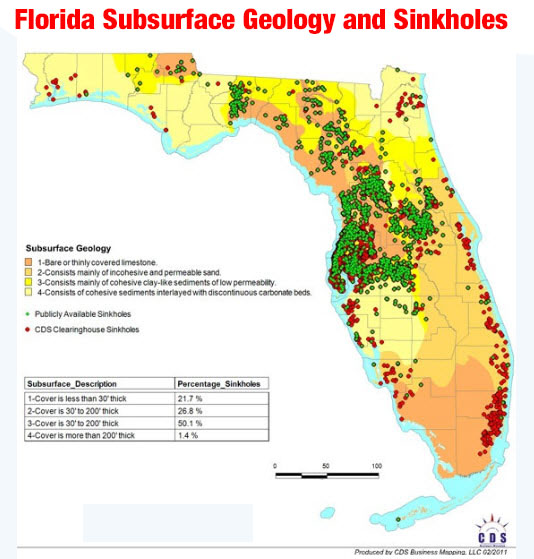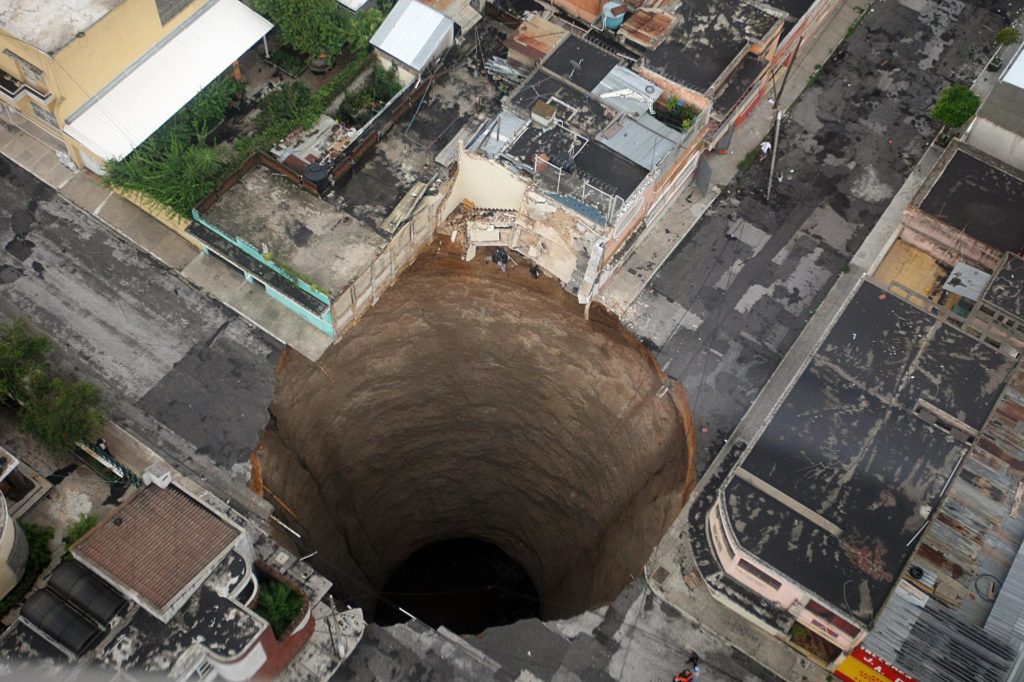
“While the entire coastline in that part of Florida is settling (sinking) a couple millimeters per year, experts say the deeply buried concrete pilings would have ensured that wasn’t a concern—unless some type of void or sinkhole opened up beneath one or more pilings, causing it to shift downward while the others remained where they were. As NBC News reports, Miami Beach is a barrier island, and while it’s not clear this was an issue with this particular situation, experts have long noted the risk of building on that type of coastline, especially as sea levels rise.” newser

Comment: Sinkholes are such a common thing in Florida … This should be considered the most probable cause of this disaster. pl
https://www.newser.com/story/307901/before-the-florida-building-collapsed-she-saw-a-sinkhole.html

After speaking with a few construction guys, they figure it’s rusted out rebar.
When I was about 18 I was a rebar guy for a while so I have some knowledge. A lot of what is hanging off the remaining wall is just rods, not mesh, it doesn’t look to have been connected too well or at all, and the spacing is ‘economical’.
Add to that the salt environment re rust as you suggested, and I’d be looking for what was found when they did any concrete cancer (spalling) repairs in recent years.
I didn’t remember the exact verse Sister Mary Alice quoted. But to this day 70 years later I remember her going on and on about building on sand after a Dorchester house collapse.
SWMBO tells me that it was undoubtedly the parable of the wise and foolish builders.
I think the cause is…cheap-as-can-be construction, paid off inspectors and then if not an actual sinkhole, then a simple downward shift of the surface soils.
Florida is karst topography – all the state lays on top of limestone made from ancient reefs. Thailand is the same – so from the Thai department of mineral resources:
Sinkholes are common where the rock below the land surface is limestone, carbonate rock, salt beds, or rocks that can naturally be dissolved by ground water circulating through them. As the rock dissolves, spaces and caverns develop underground. Sinkholes are dramatic because the land usually stays intact for a while until the underground spaces just get too big. If there is not enough support for the land above the spaces then a sudden collapse of the land surface can occur. These collapses can be small, or they can be huge and can occur where a house or road is on top.
New sinkholes have been correlated to land-use practices, especially from ground-water pumping and from construction and development practices. Sinkholes can also form when natural water-drainage patterns are changed and new water-diversion systems are developed. Some sinkholes form when the land surface is changed, such as when industrial and runoff-storage ponds are created. The substantial weight of the new material can trigger an underground collapse of supporting material, thus causing a sinkhole.
The overburden sediments that cover buried cavities in the aquifer systems are delicately balanced by ground-water fluid pressure. The water below ground is actually helping to keep the surface soil in place. Groundwater pumping for urban water supply and for irrigation can produce new sinkholes In sinkhole-prone areas. If pumping results in a lowering of ground-water levels, then underground structural failure, and thus, sinkholes, can occur.
Kind of goes back to the guys who built their hose on sand, only this time we drove pilings into the sand but the limestone below is a complete mystery as to whether it is sound or not. The key thing gleaned from the Thai mineral resource guys is that extraction of water is a root cause for sinkholes and shifting surface. With the myriad golf courses and people in Florida, the way developers control the local government, I think there are exists more than a single culprit.
So, as Forrest Gump said, “..maybe it’s a bit of both.”
In Florida most of the sinkhole problems are in the area to the east and north of Tampa Bay. This is where extensive karst has been developed due to the solution of limestone bedrock by percolating groundwater.
Sinkholes are not much of a problem in extreme southeast Florida in the greater Miami area.
Much of the built-on area in greater Miami involved the placement of hydraulic fill (which destroyed much of the coastal marshlands…..or prime mosquito habitat, depending on how one looks at it). When a heavy structure is built on these types of soils, gradual consolidation of the soil usually takes place. Geotechnical measurements indicated this building was settling at the rate of a couple of millimeters per year. This is manageable and can be engineered for (and consolidation of the soils usually decreases over time). In this case, possibly a defect in the design of the structure resulted in its failure.
There are going to be some huge lawsuits coming out of this disaster, so a thorough forensic investigation of the geotechnical engineering that went into the design of this building will be forthcoming.
Now retired, but still maintain my certification as a registered professional geologist in both Kansas and Missouri. Missouri also has extensive karst development in the Ozark Plateau and sinkholes are a problem in the Springfield area.
After over 40 years in Florida as a CGC, I suspect there will be multiple reasons for this tragedy, which will include settling, rising seas, poor construction methods and incompetent inspectors, etc. I have my doubts about sinkholes that are rare in that area and frequently they would be much bigger. I also live in a HOA and have lived in others and they are notoriously slow in taking action when confronted with structural issues. We may also not find all the reasons and in which order they impacted the destruction. Like after Hurricane Andrew, there may be some rewriting of the building codes too.
Prying money out of Home Owners Association (HOA) for repairs, in this case $9 million dollars as reported, is never a pretty picture. Lots of blame can be cast all around. HOA’s prove democracy is good in theory, but rarely in practice.
Florida International University Professor of Geology thinks that there will probably a few reason but, interesting nearby construction might have been one of causes for instability:
https://www.wfla.com/news/florida/ground-under-collapsed-florida-condo-had-been-shifting-since-1990s-geologisthe cause
https://case.fiu.edu/about/directory/profiles/wdowinski-shimon.html
I suggest an influx of yankees over years, causing increased water use and corresponding saltwater intrusion and lowering total water levels in the aquifer locally, as well as expanding waistlines causing excessive stress on each floor of the building.
Whatever the causes of this disaster, there will be countless lawsuits – likely dragging on for years to come. I’ve read that this particular building had $9 million in deferred maintenance, so the condo association will be likely defendants, among several others. But it’s very difficult for condo associations to proceed with costly repairs in many cases because consensus among individual condo owners can be so hard to come by. This is why my husband, fastidious property manager that he is, refuses to ever consider living in a condominium, especially a high-rise in a coastal area! Fastidious residents are dragged down by the lowest common denominators – residents who refuse to agree to pay for needed repairs. Imagine all of the high-rise condos AROUND THE WORLD that may be vulnerable to similar catastrophe, due to the decades-long major population shift to coastal areas.
Where will the money come from to fulfill settlement terms for multiple plaintiffs who’ve been awarded millions of dollars? It all boggles the mind. For years, I’ve resented the socialization of risk benefiting the [usually very wealthy] people who choose to live in trouble-prone coastal areas. Maybe a reckoning is on the way. In the meantime, what a tragedy for those effected in Florida, what a nightmare for those in potentially similar situations.
probably did not need much to bring it down.all the structural weaknesses were documented and known.
Own property in the capital of sinkholes, Pasco County. It’s a mess, but you don’t really have much high rise construction in the county (moreso just south in Pinellas). As far as condo board, wonder what percentage of units are owner occupied? I don’t see absentee owners being that interested in doings of the association, other than not wanting special assessments. We’ve had an issue in Honolulu where a condo had a major fire, and the issue was it was built prior to mandated sprinklers. The HFD would prefer every dwelling to have sprinklers but no one wants to pay for it.
This reminded me of the hotel collapse in New Orleans, but that one was under construction so the finger pointing was between design, and construction, and inspection. Likewise the Mexico City train collapse. I suspect if you look closely at any big job you can find welds with poor penetration, concrete pours not to spec, etc. We in the USN engineering community had problems in submarine work, leading to the “subsafe” program.
I am sure there will be lawsuits filed and some of them will be rather speculative. Any owner, or their estate, will have a hard time suing the Association, since they are members of it and suing yourself is an arduous task. The board members seem to have tried to deal with the problems and as long as they obtained outside experts, Florida courts have ruled that they have done their duty and the same court have ruled that they did not have to take any advice or act on it.
Of course, if John Morgan shows up, all that may change. What is more important is that something valuable is learned from this to mitigate future problems. There have been improvements made in California to earthquake proof concrete columns and that should be considered. What is called “floating” slabs may also be banned. From an insurance case in Miami that I was involved with 15 years ago I know that the limestone substrata is very stable. Plenty of research was done as they built the Metro regarding stability. But the rest is basically a sand pile and that can move. I do hope something beneficial with come out of this and not just a lot of dead people who did not deserve to die.
Update, pool contractor documents damage before collapse:
https://www.miamiherald.com/news/local/community/miami-dade/miami-beach/article252421658.html